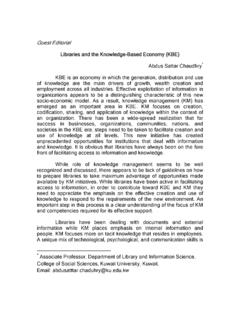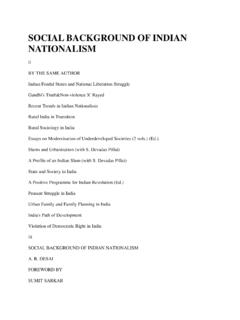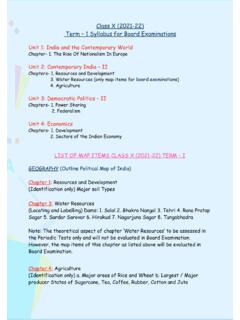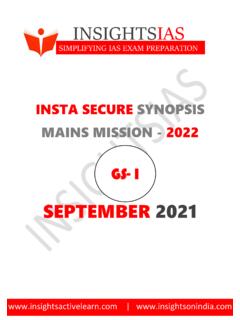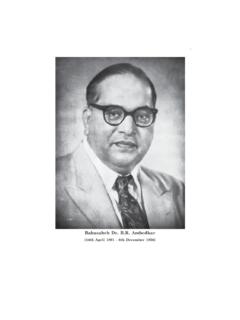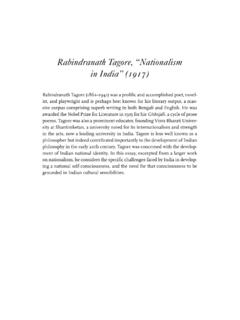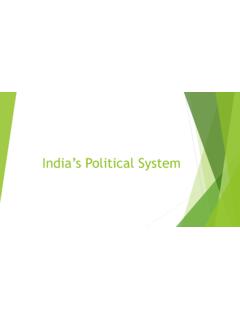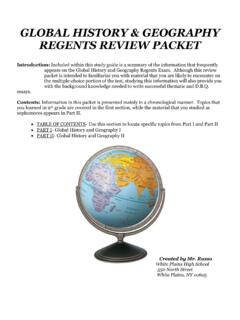Transcription of KASHMIR: A Conflict between India and Pakistan
1 149 South Asian Studies A Research Journal of South Asian Studies Vol. 31, No. 1, January June 2016, pp. 149 159 KASHMIR: A Conflict between India and Pakistan Abdul Majid University of the Punjab, Lahore. Mahboob Hussain University of the Punjab, Lahore. ABSTRACT Kashmir is the oldest and the most serious dispute between Pakistan and India . Various efforts at the bilateral and multilateral levels could not resolve this problem. The two countries have fought hot and cold wars which undermined their bilateral relations. India s efforts to strengthen its control of Kashmir by use of force have always been questioned by Pakistan that supports Kashmiri demand for right self determination under the UN Resolution of 1948-49.
2 This paper analysis the origins of the Kashmir dispute, its influence on Indo- Pakistan relations, and the prospects for its resolution. Key Words UN Resolution, Human Rights Violations, Human Tragedy, LOC. Introduction India s efforts to integrate Kashmir into Indian Union did not succeed because the major Kashmiri leaders and parties resisted these efforts. The Kashmiris want that they should themselves decide about their political future, as committed to them by the UN Resolutions of 1948-49. Indian leadership contests this and use force to crush this demand. This has caused a perpetual Conflict between the Indian authorities and the people of Kashmir.
3 India has been using security establishment to control Kashmir which often resulted in human rights violations in Kashmir. Indian actions are driven by the consideration of keeping Kashmir under its control irrespective of the human rights or other cost. The excessive use of security forces and state power by India has the Kashmir Valley into a Human Tragedy. The Indian government use security forces and intelligence establishment to subdue Kashmirs. The Kashmiri people want freedom from India and decide their political future on their own. This is not acceptable to India and it use force to control Kashmiris.
4 We remember the statement of Sardar Patel, who said, give Jinnah his state, it would not survive in five years, the Muslim league would be knocking at their door begging for India s reunification (Collins & Lapierre, 2011). South Asian Studies 31 (1) 150 The interview of Quaid-e-Azam Muhammad Ali Jinnah in Daliy Hamdard about Kashmir situation on Feb 3, 1946 is very important and relevant to this article. He said:- Although I am fully occupied with the British Indian elections just now yet I have not forgotten the problems of Kashmir he said, I am fully conscious of the suffering of the people there and that though the burden of the struggle against repression and oppression was mainly to be born by the people of Kashmir, we shall always help them in every possible (Collins & Lapierre, 2011).
5 He also said; In search of an inventive approach to untangle the Kashmir Knot, the merit of the case was not a good starting point. Firstly, we might not agree on the merit: we did not for over six decades. Secondly, and more importantly: complex issues are not resolved by providing one or the other side wrong, but by identifying common causes that can be pursued together (Murshed, 2014). Geographical and Historical Background The state of Jammu and Kashmir comprises the regions of Kashmir valley, Jammu and Ladakh with approximately 10 million people. According to Burke and Salim-ud-Din Quraishi, the population figure of Jammu and Kashmir State on the eve of transfer of power, were as under: Jammu Muslims 1208675 61% Hindus 772760 39% Kashmir Muslims 1489988 92% Hindus 139217 8% Jammu & Kashmir Present Total Muslims in the state 3101247 77% Total Hindus in the state 809165 21% Total Sikhs to the state 65903 Total Buddhist in the state 40696 Total Population 4021616 The Jamrnu and Kashmir Conflict dates back to the partition of the subcontinent in 1947.
6 The first India - Pakistan war over Kashmir soon after the independence resulted in the division of the territory into Indian held Jammu and Kashmir (comprises the regions of Kashmir valley, Jammu and Ladakh) and the smaller area with Pakistan (Azad Kashmir plus sparsely populated regions in the High Himalayas known as Pakistan 's Northern Areas now designated as Gilgit Baltistan. (Imperial Gazatteer of Kashmir and Jammu, 2002). Abdul Majid & Mahboob Hussain KASHMIR: A Conflict 151 The dividing line between Azad Kashmir and Northern Areas and Indian administered Kashmir originated in a Cease Fire line in 1949 under the UN Resolutions.)
7 It was marginally altered during Indo- Pakistan 1971 and renamed as the Line of Control (LoC) under the India Pakistan agreement signed at Simla in July 1972. Both India and Pakistan have contesting claims of sovereignty over the territory of Jammu and Kashmir. They both raised their claims at the UN and also the fight for the Kashmir several times in the past. The majority of the population of the Kashmir is now fed up with this dispute and some of them also want to see Kashmir as an independent state. The problems between India and Pakistan are very largely a legacy of their histories including the histories of Indian and Pakistani nationalism .
8 The indian nationalism advocated a secular, pluralist India where all religions should co-exist. The Muslim League argued that India comprised of two nations: Muslims and Hindus and that because of irreconcilable historical, political, social and cultural differences and contradictions. Since indian nationalism was secular it could not concede to the idea of Kashrnir s accession to Pakistan . Therefore, Kashmir was held hostage to the two nationalisms. Both of whom had held on to what parts of Kashmir they controlled and wanting control of the rest. Kashmir is a very complex dispute, it is an ethnic dispute it is a religious dispute, it is a territorial dispute, it is a dispute over Human Rights, but above all it is a dispute about the right of the Kashmiri people to determine their own political future.
9 Apart from the terrible suffering and deprivation, the people of Kahmir have suffered and are suffering. They have also paid a terrible price. The Kashmir problem was sought not to be resolved by dialogue but by bloodshed not by force of reason but by the reason of force. The option of plebiscite to settle the dispute of Kashmir was originally suggested by the Indian leadership in 1947 when the dispute arose over the accession of the princely state of Jammu and Kashmir both Lord Mountbatten (the Government General of India ) and Jawahar Lal Nehru. (Indian prime minister) categorically stated the option of plebiscite to know the wishes of the dispute of Kashmir.
10 India took the case to the and option of plebiscite was institutionalized in the two cardinal resolution of the passed in 1948-49. However, the plebiscite was never held and India did not honor its pledge. Pakistan considers the Indian pledges to be binding today as it was when first voluntarily made in 1947-1948. Indian politician have used this emotive issue to scare their public that Indian might break-up if Kashmir separates from it. The plebiscite solution of the Kashmir issue is rejected by India and according to the Indian perception, it smacks of the 'two nation theory' as it is based on two-nation theory which India rejects.
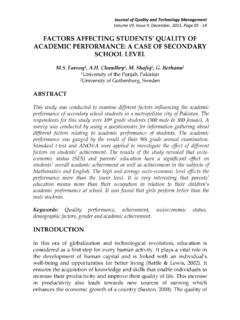





![nÁ0` h]´ VP h^ÄE°h´ÅÊQ⌦µh^˨½ DÅ⌦En¨½ À¹ ÌÄjÅ⌦ÊPÅj {´Ì](/cache/preview/7/8/7/0/6/2/b/7/thumb-787062b7e87e0e8e4ae0396a2098f16c.jpg)

